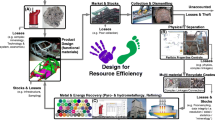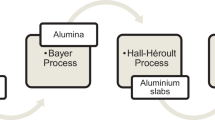Abstract
Recycling and process metallurgy are the main enablers of Circular Economy (CE). To assess the circularity of CE, a detailed understanding of the limits of the current recycling infrastructure is required. For this paper, a predictive physical separation model for Eddy Current Separator was developed using 3D particle-level detail acquired by Computed Tomography. The developed model was combined with re-melting and alloying models to create an aluminum recycling flowsheet in a simulation platform HSC Sim. Different simulation scenarios were considered, and the impact of the physical separation stage to resource efficiency was quantified by measuring the required additional resources to produce specific alloy types. The resource efficiency and environmental impacts were estimated through exergy analysis and Life Cycle Assessment based on the detailed physical and thermochemistry simulation models. The paper demonstrates how digitalization and exergy analysis allow more efficient use of resources in the sense of CE.








Similar content being viewed by others
References
Geissdoerfer M, Savaget P, Bocken NMP, Hultink EJ (2017) The circular economy—a new sustainability paradigm? J Clean Prod 143:757–768
Reuter MA, van Schaik A, Gutzmer J, Bartie N, Abadías-Llamas A (2019) Challenges of the circular economy: a material, metallurgical, and product design perspective. Annu Rev Mater Res 49:253–274
European Aluminium Association (2018) Environmental profile report: life-cycle inventory data for aluminium production and transformation processes in Europe. https://european-aluminium.eu/resource-hub/environmental-profile-report-2018/
European Aluminium Association (2015) Recycling aluminium: a pathway to a sustainable economy, p. 3990. https://www.european-aluminium.eu/media/1712/ea_recycling-brochure-2016.pdf
Xiao Y, Reuter MA, Boin U (2005) Aluminium recycling and environmental issues of salt slag treatment. J Environ Sci Heal Part A 40(10):1861–1875
Biganzoli L, Gorla L, Nessi S, Grosso M (2012) Volatilisation and oxidation of aluminium scraps fed into incineration furnaces. Waste Manage 32(12):2266–2272
Nakajima K, Takeda O, Miki T, Matsubae K, Nakamura S, Nagasaka T (2010) Thermodynamic analysis of contamination by alloying elements in aluminum recycling. Environ Sci Technol 44(14):5594–5600
Gaustad G, Olivetti E, Kirchain R (2012) Improving aluminum recycling: a survey of sorting and impurity removal technologies. Resour Conserv Recycl 58:79–87
Capuzzi S, Giulio T (2018) Preparation and melting of scrap in aluminum recycling: a review. Metals (Basel) 8(4):249
Werheit P, Fricke-Begemann C, Gesing M, Noll R (2011) Fast single piece identification with a 3D scanning LIBS for aluminium cast and wrought alloys recycling. J Anal At Spectrom 26(11):2166–2174
Barnabé P, Braibant L, Dislaire G, Leroy S, Pirard E (2018) Non-ferrous scrap metals classification by hyperspectral and multi-energy X-ray transmission imaging. 8th Sens Based Sort Control Proc, pp. 39–47
Picón A (2012) Real-time hyperspectral processing for automatic nonferrous material sorting. J Electron Imaging 21(1):013018
Candiani G, Picone N, Pompilio L, Pepe M, Colledani M (2017) Characterization of fine metal particles derived from shredded WEEE using a hyperspectral image system: preliminary results. Sensors (Switzerland) 17(5):1117
Chang J, Olivetti E, Fjeldbo SK, Kirchain R (2015) Data mining toward increased use of aluminum dross. J Sustain Metall 1(1):53–64
Li P, Dahmus J, Guldberg S, Riddervold HO, Kirchain R (2011) How much sorting is enough: identifying economic and scrap-reuse benefits of sorting technologies. J Ind Ecol 15(5):743–759
Borrotti M, Pievatolo A, Critelli I, Degiorgi A, Colledani M (2016) A computer-aided methodology for the optimization of electrostatic separation processes in recycling. Appl Stoch Model Bus Ind 32(1):133–148
Hiraki T, Miki T, Nakajima K, Matsubae K, Nakamura S, Nagasaka T (2014) Thermodynamic analysis for the refining ability of salt flux for aluminum recycling. Materials (Basel) 7(8):5543–5553
Xiao Y, Reuter MA (2002) Recycling of distributed aluminium turning scrap. Miner Eng 15(11 Suppl. 1):963–970
Zhou B, Yang Y, Reuter MA, Boin UMJ (2006) Modelling of aluminium scrap melting in a rotary furnace. Miner Eng 19(3):299–308
Ayres RU, Ayres LW, Martínas K (1998) Exergy, waste accounting, and life-cycle analysis. Energy 23(5):355–363
Finnveden G, Arushanyan Y, Brandão M (2016) Exergy as a measure of resource use in life cyclet assessment and other sustainability assessment tools. Resources 5(3):23
Amini SH, Remmerswaal JAM, Castro MB, Reuter MA (2007) Quantifying the quality loss and resource efficiency of recycling by means of exergy analysis. J Clean Prod 15(10):907–913
Castro MBG, Remmerswaal JAM, Reuter MA, Boin UJM (2004) A thermodynamic approach to the compatibility of materials combinations for recycling. Resour Conserv Recycl 43(1):1–19
Abadías Llamas A et al (2019) Simulation-based exergy, thermo-economic and environmental footprint analysis of primary copper production. Miner. Eng. 131(2018):51–65
Stotz PM, Niero M, Bey N, Paraskevas D (2017) Environmental screening of novel technologies to increase material circularity: a case study on aluminium cans. Resour Conserv Recycl 127:96–106
Gatti JB, De Castilho-Queiroz G, Garcia EEC (2008) Recycling of aluminum can in terms of life cycle inventory (LCI). Int J Life Cycle Assess 13(3):219–225
Soo VK, Peeters J, Paraskevas D, Compston P, Doolan M, Duflou JR (2018) Sustainable aluminium recycling of end-of-life products: a joining techniques perspective. J Clean Prod 178:119–132
Niero M, Olsen SI (2016) Circular economy: to be or not to be in a closed product loop? A life cycle assessment of aluminium cans with inclusion of alloying elements. Resour Conserv Recycl 114:18–31
Paraskevas D, Kellens K, Dewulf W, Duflou JR (2015) Environmental modelling of aluminium recycling: a life cycle assessment tool for sustainable metal management. J Clean Prod 105:357–370
Reuter MA, van Schaik A, Gediga J (2015) Simulation-based design for resource efficiency of metal production and recycling systems: cases—copper production and recycling, e-waste (LED lamps) and nickel pig iron. Int J Life Cycle Assess 20(5):671–693
Outotec, HSC Sim 9.9, (2019). https://www.outotec.com/products/digital-solutions/hsc-chemistry/. Accessed 27 Sept 2019
Thinkstep, GaBi Software, (2019). https://www.thinkstep.com. Accessed 27 Sept 2019
Pyral AG, (2019). https://www.pyralag.com/. Accessed 27 Sept 2019
Steinert, (2019). https://steinertglobal.com/. Accessed 04 Oct 2019
XRE-Tescan, (2019). https://xre.be/. Accessed 27 Sept 2019
Schindelin J et al (2012) Fiji: an open-source platform for biological-image analysis. Nat Methods 9(7):676
Arganda-Carreras I et al (2017) Trainable Weka segmentation: a machine learning tool for microscopy pixel classification. Bioinformatics 33(15):2424–2426
FEI Company, Avizo 9.3. (2019). https://www.fei.com/software/avizo/?LangType=2052. Accessed 27 Sept 2019
The MathWorks Inc (2019a) MATLAB and Statistics and Machine Learning Toolbox Release 2019a. The MathWorks Inc, Natick
Hannula J, Kern M, Luukkanen S, Roine A, van den Boogaart KG, Reuter MA (2018) Property-based modelling and simulation of mechanical separation processes using dynamic binning and neural networks. Miner Eng 126(June):52–63
Llewellyn D, Hudd R (1998) Steels: metallurgy and applications. Elsevier, Amsterdam
Factsage 7.3, (2019). https://www.factsage.com/. Accessed 27 Sept 2019
ISO, ISO 14040:2006 (2006) Environmental management—life cycle assessment—principles and framework.
ISO, ISO 14044:2006 (2006) Environmental management—life cycle assessment—requirements and guidelines
Valero A, Serra L, Uche J (2006) Fundamentals of exergy cost accounting and thermoeconomics. Part I: theory. J Energy Resour Technol Trans ASME 128(1):1–8
Szargut J (1989) Chemical exergies of the elements. Appl Energy 32(4):269–286
Castro MBG (2005) Design for resource efficiency—preserving the quality in the (automotive) resource cycles, Doctoral Thesis.
Valero A, Usón S, Torres C, Stanek W (2017) Theory of Exergy Cost and Thermo-ecological Cost. In: Stanek W (ed) Thermodynamics for sustainable management of natural resources. Springer, Cham, pp 167–202
Zheng J, Ruan J, Dong L, Zhang T, Huang M, Xu Z (2017) Hollow aluminum particle in eddy current separation of recovering waste toner cartridges. ACS Sustain Chem Eng 5(1):161–167
Rem PC, Leest PA, van den Akker AJ (1997) A model for eddy current separation. Int J Miner Process 49(3–4):193–200
Maraspin F, Bevilacqua P, Rem PC (2004) Modelling the throw of metals and nonmetals in eddy current separations. Int J Miner Process 73(1):1–11
Acknowledgements
PYRAL AG is acknowledged for providing the sample material. TU Bergakademie Freiberg is acknowledged for the use of its facilities and machinery for the separation tests with Eddy Current Separator. We also thank the valuable comments from the anonymous reviewers. The funding was provided by Helmholtz-Gemeinschaft (Grant no. 1022280014).
Author information
Authors and Affiliations
Corresponding author
Ethics declarations
Conflict of interest
The authors declare that they have no conflict of interest.
Additional information
The contributing editor for this article was Hongmin Zhu.
Publisher's Note
Springer Nature remains neutral with regard to jurisdictional claims in published maps and institutional affiliations.
Electronic supplementary material
Below is the link to the electronic supplementary material.
Rights and permissions
About this article
Cite this article
Hannula, J., Godinho, J.R.A., Llamas, A.A. et al. Simulation-Based Exergy and LCA Analysis of Aluminum Recycling: Linking Predictive Physical Separation and Re-melting Process Models with Specific Alloy Production. J. Sustain. Metall. 6, 174–189 (2020). https://doi.org/10.1007/s40831-020-00267-6
Published:
Issue Date:
DOI: https://doi.org/10.1007/s40831-020-00267-6




